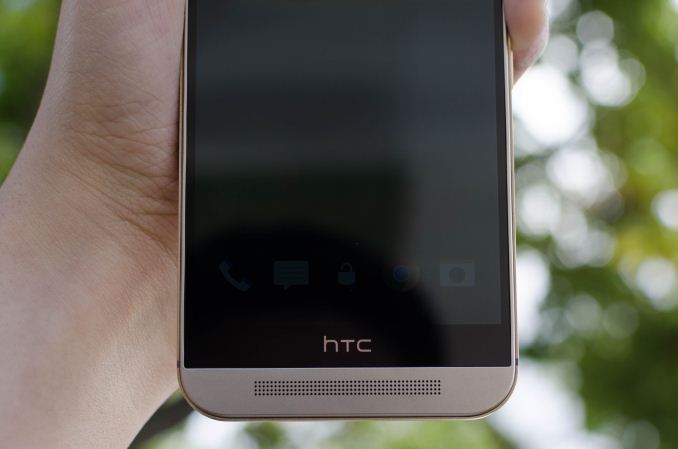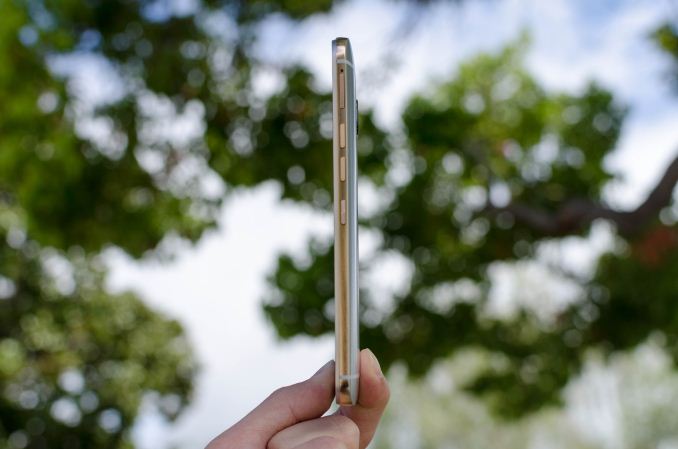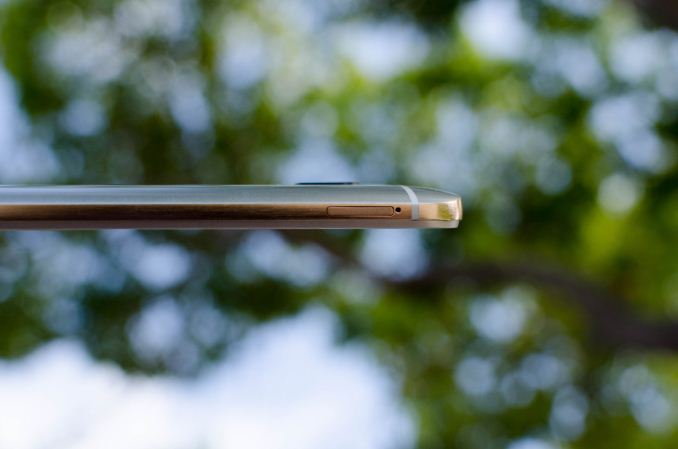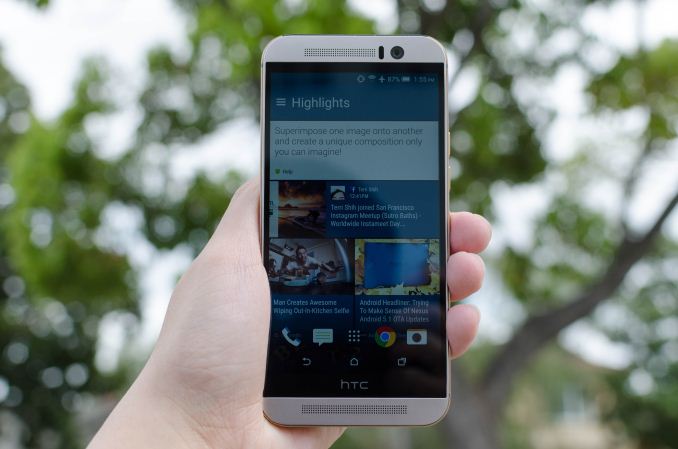The HTC One M9 Review: Part 2
by Joshua Ho on April 6, 2015 10:00 AM EST- Posted in
- Smartphones
- HTC
- Qualcomm
- Mobile
- Snapdragon 810
- One M9
Final Words
Now that we finally have all of the pieces together, we can come to some proper conclusions about the HTC One M9. For those that haven’t read part one of this review, it’s really necessary to do so to understand the context in which these comments are made.
There’s a lot to talk about here, so we’ll start with the design of the phone. HTC is probably the company best-known for design in the Android space, and with the One M9 it seems that they hope to capitalize on this by electing not to significantly change the design.
However, there are a few key changes to the One M9’s design when comparing it to the One M8. For instance, the One M9 moves the power button to the right side of the phone, changes the finish of the back cover, squares off the back cover, and replaces the front plastic bezel with a new plastic bezel. All of these changes seem to make some sort of sense at first, but they almost feel like a regression in some ways. The power button is on the side, but it takes a lot of effort to press it when the phone is held normally in the hand. However, it’s conveniently placed to accidentally press when picking the phone up from a table.
Meanwhile the back cover has a new finish and a neat dual-anodized color, but I question the value of these changes when they reduce yield and drive cost up, especially when sand-blasted anodized aluminum is comparable in look and feel. The continued use of the plastic bezel on the front also cheapens the feel of the phone. The new hard edges on the back cover is also quite uncomfortable, especially when compared to the M8’s smoother curve. There is also the issue of the “logo bar” bezel, but it’s physically impossible to get rid of this bezel due to engineering constraints.
The next aspect worth examining is the display. To HTC’s credit, a 1080p display at 5 inches is the right tradeoff to make with an RGB-stripe display. However, it’s concerning to see significant regressions in almost every area when comparing the display to the M8. An amazing display is almost a requirement for flagship smartphones at this point, and to see such a poor display with equally poor calibration is disappointing. It was clear in the past that HTC genuinely cared about delivering an amazing display, but somewhere along the way it seems that they forgot. We can speculate about the reasons behind this, but this is something that HTC has to fix if they want to remain relevant in the smartphone space, just like every other OEM at this point.
The other critical point of a smartphone is its ability to remain mobile. Battery life is probably the most important aspect of any smartphone, and a poor showing here can be enough to write off a phone. HTC has traditionally done quite well here despite using a smaller battery in their phones than average. Unfortunately, this isn’t true of the One M9. Despite using a newer SoC and a bigger battery, HTC regresses significantly in battery life when compared to the One M8. Although it seems that MIPI command mode has been removed from the One M9, it’s likely that most of the increased power draw can be directly attributed to the SoC, as the impact of panel self-refresh is relatively small.
Speaking of the SoC, the Snapdragon 810’s performance does generally provide a decent improvement over the Snapdragon 805, but it’s relatively little due to HTC’s governor settings which make it quite difficult to reach the maximum 2 GHz state. GPU performance is better than what we see on the Galaxy S6, but this is due to HTC’s choice to stay at a lower native resolution. At the same resolution, the Exynos 7420’s Mali T760 GPU is faster due to higher clock speeds. It’s also disappointing that HTC continues to use benchmark optimizations. The difference in performance is so small at this point that HTC should seriously consider removing these optimizations altogether, as it isn’t worth getting delisted from multiple benchmarks.
The camera of the One M9 is also a weak point, despite significant changes on HTC’s part in this area. Unfortunately, the post-processing here is just not acceptable, and the results of the camera are equally unacceptable. We will have to see how the camera performs without HTC’s heavy-handed post-processing when they update the camera to shoot in RAW, but HTC needs to improve dramatically here for next year.
The one positive note here is Sense 7, which continues to be one of the best experiences in Android overall. I fundamentally disagree with the assertion that a user should go to the Play Store to find various applications that they like, as taking this to its logical conclusion basically ends with having to download a dialer application from the Play Store on first boot. Blinkfeed continues to be a solid application for news, social media, and other information, and HTC’s apps in general are a strong point of differentiation judging by the demand from users to port them to non-HTC phones. However, I still think that HTC didn’t do enough for this iteration of Sense. Most of the applications still feel like they mesh best with Android 4.4, and overall the UI needs to be redesigned to fit with Material Design.
Overall, further testing of the One M9 basically confirms my fears, which were that the One M9 is effectively a sidegrade of the One M8 at best. I really did want to like this phone, as I still find the One M7 to be a great phone to use. I really wanted to see a phone from HTC that was worthy of an upgrade from the One M7, but the One M9 isn’t that phone. In fact, given that the One M8 is at least 200 dollars cheaper than the One M9 on contract, I find it incredibly difficult to recommend the One M9. It will definitely have its fans, but overall there are more negatives than positives. Given the competitive positioning of the One M9, the timing of the Snapdragon 810, and the strength of the Galaxy S6 I’m faced with an intense sense of déjà vu. It almost feels like we’re back where we started 3 years ago with the Sensation and Galaxy S2. I can't think of a better way to describe the situation HTC is in, which is alarming to say the least. The One M9 can't be another Sensation, but it feels like it is.














127 Comments
View All Comments
Aenean144 - Monday, April 6, 2015 - link
I wonder if it's HTC chosen phone design architecture that's giving them troubles here, camera aside as who knows why that's been out of sorts.HTC sandwiches the battery between the LCD and the PCB (containing SoC, modem etc). This design is fine if all of the components hit their power envelopes, but everything is working against HTC here. When the SoC or wireless modem gets hot, the battery acts like a heat sink plus however much heat is taken out by the back casing.
Then, a quick charge where you're putting 10+ Watts into charging the battery is going to heat up that battery a bit.
Just seems like two bad things that can make things worse really fast. I imaging playing a game or doing something processor intensive while quick charging would not be a good thing to do here.
Despoiler - Monday, April 6, 2015 - link
I upgraded from an M7 to an M9. For me the camera is not so important because it all gets uploaded to social media. For me the killer features are the audio. I must have high audio quality from my phone. The M9 has amazing audio quality from all outputs (speaker or headphone). It's mind blowing how good it is. The Dolby mode has some serious mojo going on. It's comical how bad the Beats mode was compared to it. The Dolby mode is so good it works brilliantly on all types of music, which shouldn't be possible.Despoiler - Monday, April 6, 2015 - link
Also, where is the audio section of the review? Seriously how do you omit one of the biggest selling points of this phone?Dorek - Wednesday, April 8, 2015 - link
Yeah. I can excuse glossing over the external speakers for media, but not for speakerphone; that is a very, VERY important thing to consider. And to not test the headphone output is also very stupid.Digekari - Monday, April 6, 2015 - link
What about the internal audio? I was really interested in that.TallestJon96 - Monday, April 6, 2015 - link
So the m9 is WORSE than the m8? That's a shame, as I almost purchased an m8, and was hoping a future model could replace my iPhone, but if they are getting worse, than I'll stay away.cryosx - Monday, April 6, 2015 - link
I have a feeling we're going to need to disable 4 cores, that'll make it run like the S801 and hopefully reign in on excessive heat. Maximum performance will suffer but battery life will hopefully return to M8 levels and or surpass it.melgross - Monday, April 6, 2015 - link
I don't understand this 8 core crap. Two or three years ago, it might have made sense to have four weak, but low power cores for much of the work, and four high end cores for the latest games, camera processing, etc.But that never really worked out that well. When Samsung decided to use all eight at the same time, it was a really dumb idea. Not only are the two core types of differently strengths, but they also have slightly different instruction sets. And as we've already seen in at least one review, sometimes going to the weak cores uses more battery power than using the strong cores because of the time of processing, and other constraints of these cores.
And using all eight at the same time often results in slower processing because the two core sets can't process exactly the same way, and things get jammed up.
The problem here is that some manufacturers are just thinking of marketing. It's just SO much better to advertise 8 cores than 4. But Apple gets better performance out of three!
Something's got to give. They should just drop the weak cores altogether, and work on making the four strong cores better, and more efficient.
TrojMacReady - Saturday, April 11, 2015 - link
Just no.The current 7420 Exynos gets better performance than any A8 smartphone SoC (at the same resolution) all around. In practise (except gaming at native resolution) too, despite pushing many more pixels (up to a factor 3.7).
As for a comparison to the A8X, that's flawed in so many ways. Its TDP is up to twice as high and it's almost twice as large too. People are already complaining about the heat it produces in a large iPad, consider it sitting in a smartphone... The 7420 CPU outpaces it, despite the above differences, the GPU is 10-20% slower. But with much less power consumption and heat as a bonus. I guess those 8 cores aren't so bad afterall.
mrochester - Monday, April 6, 2015 - link
The Android death knell sounds. This is what happens when you use the same software and ecosystem as your competitors.